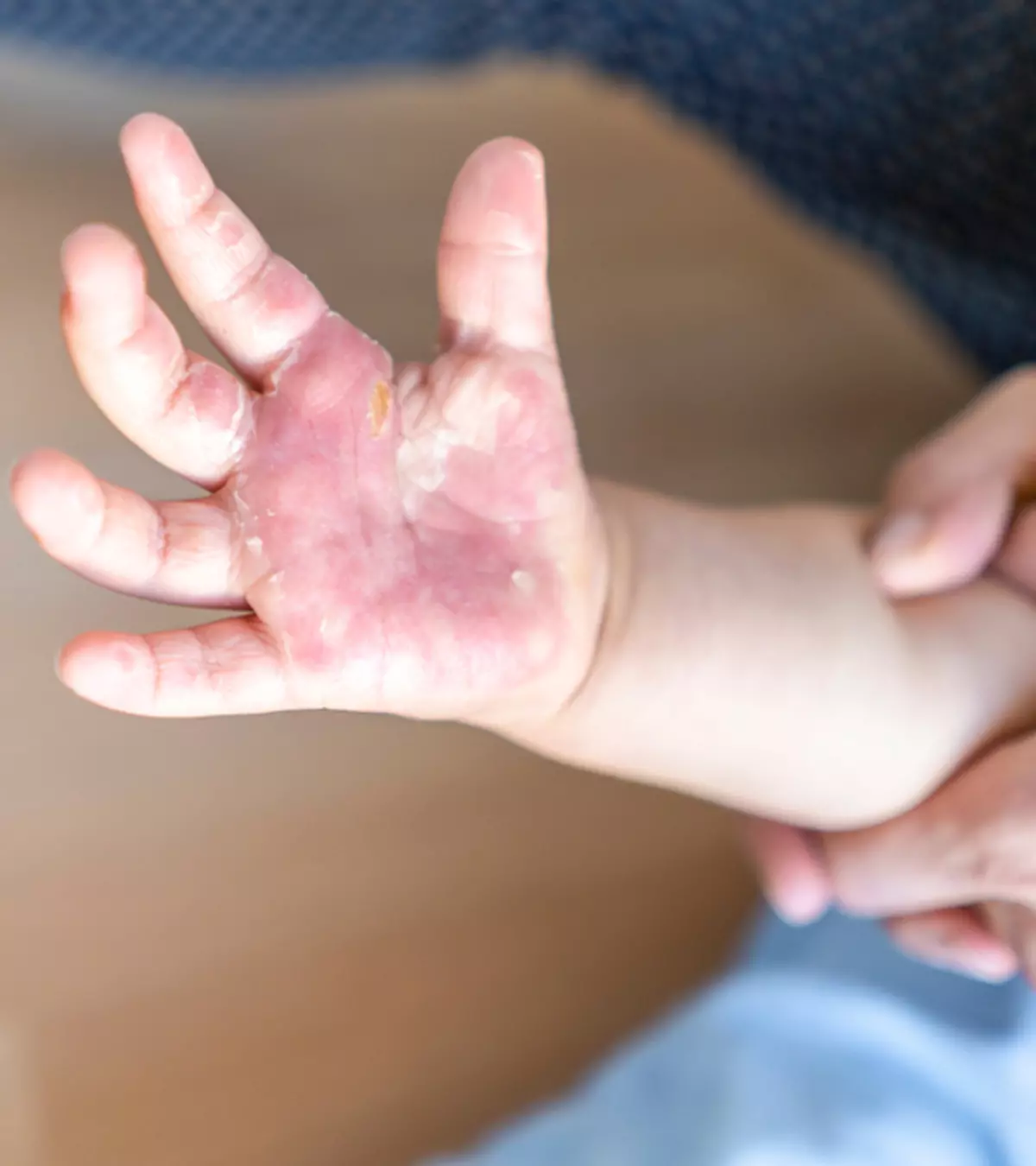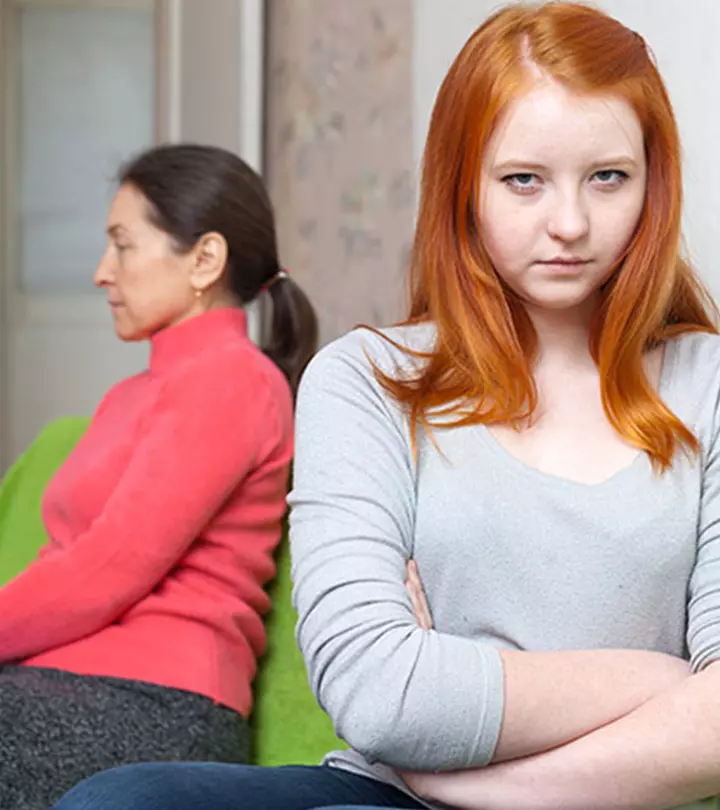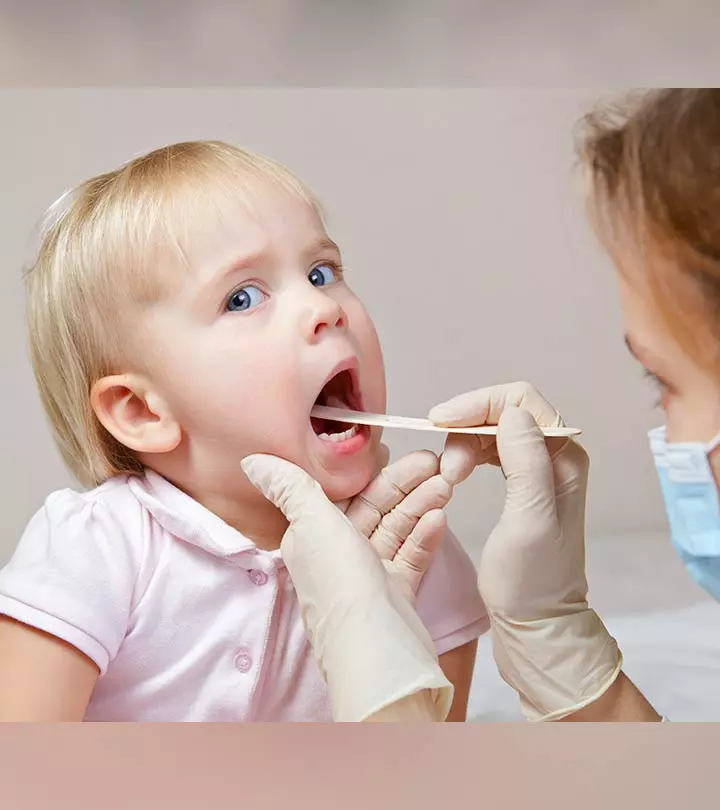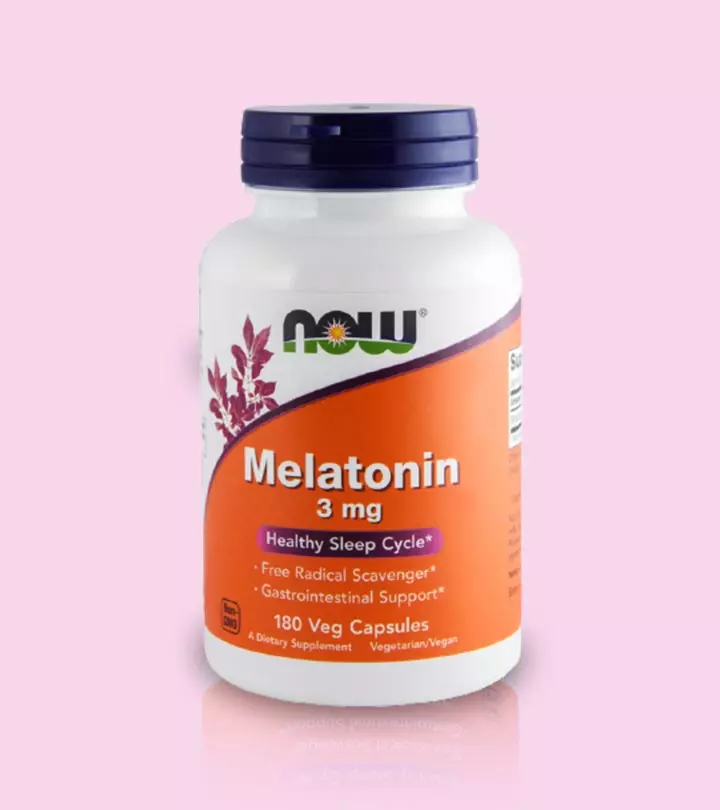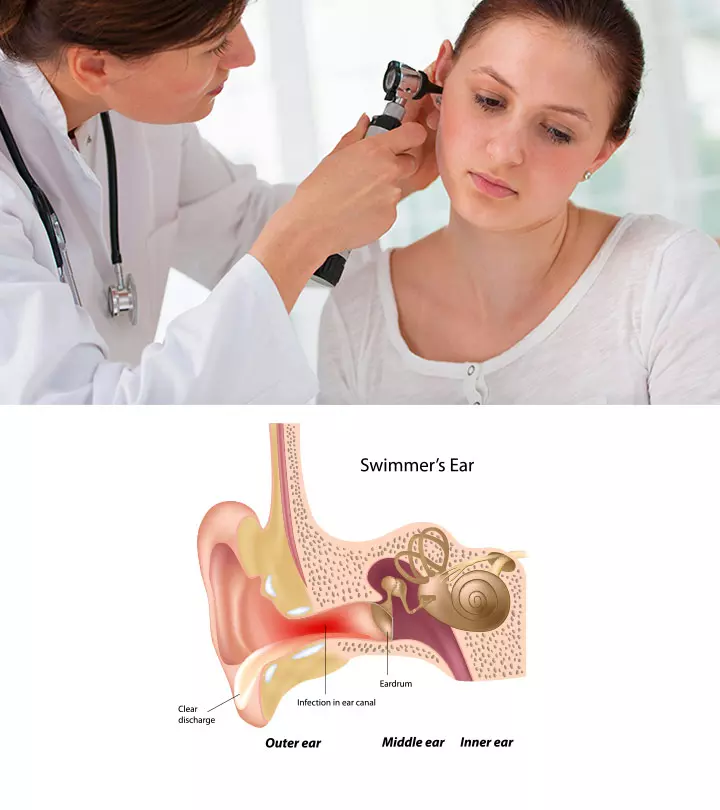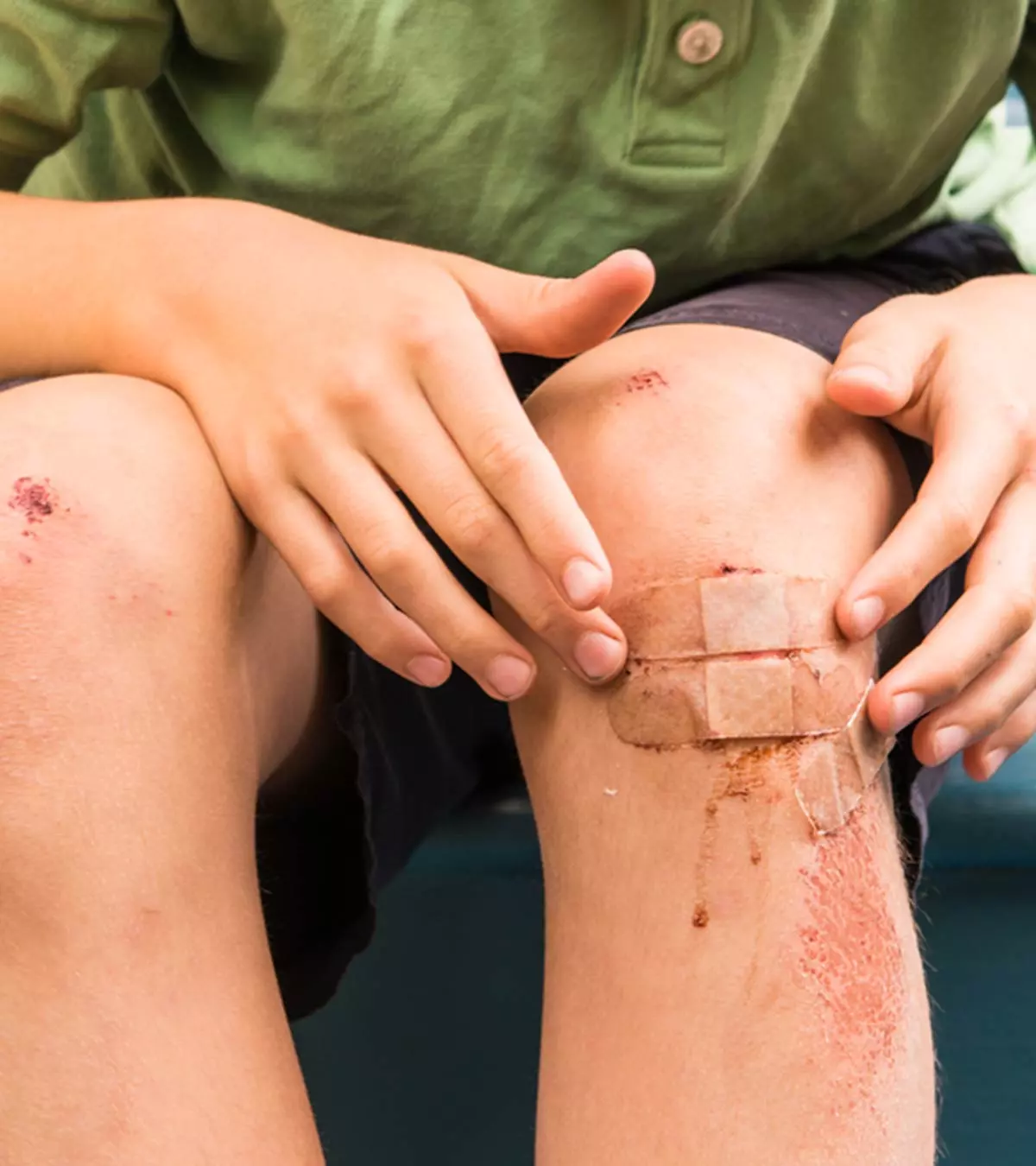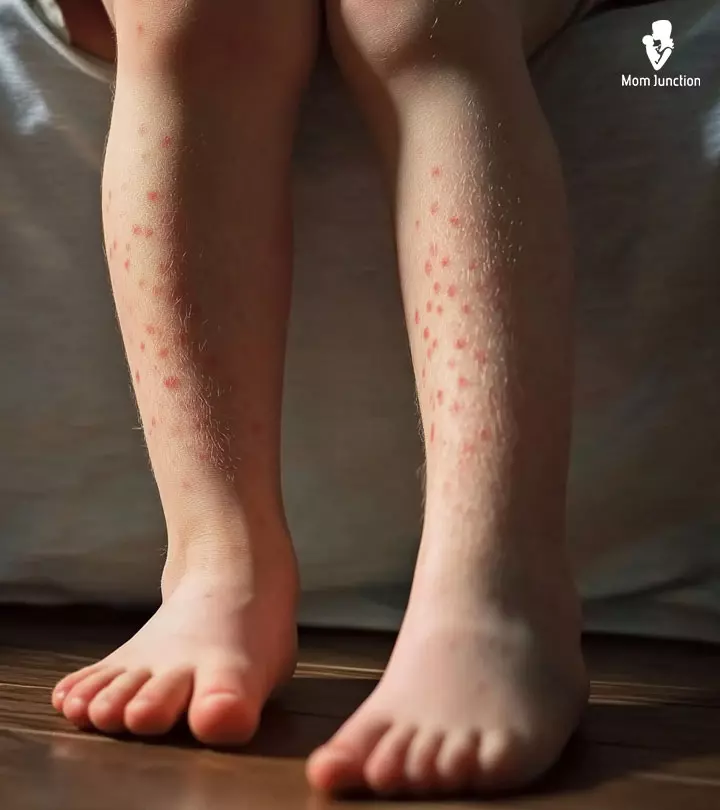
Image: Midjourney/ MomJunction Design Team

Roseola in children is often caused by human herpesvirus 6 (HHV-6) and less frequently by human herpesvirus 7 (HHV-7) (1). Usually, most children get roseola infection before four years of age, and children younger than two years are commonly affected (2).
This viral infection is also called exanthema subitum, roseola infantum, or the sixth disease, and is highly contagious. Nevertheless, it is a self-limiting disease. Most children can be treated symptomatically.
Read on to know more about this contagious viral infection, its symptoms, causes, diagnosis, treatment, and preventive measures.
Key Pointers
- Roseola in children is often caused by human herpesvirus 6 (HHV-6) though in some cases, human herpesvirus 7 (HHV-7) could also be the cause.
- Five and 15 days after virus exposure, children may develop symptoms, such as sudden high-grade fever, swollen eyelids, cough, and runny nose.
- If a child has a high fever, complications such as febrile seizures and dehydration can occur.
- The treatment for roseola focuses on providing symptomatic relief.
- Maintaining optimum hygiene and practicing cough and sneeze etiquette could help prevent infection.
Risk Factors And Causes Of Roseola In Children
Roseola in children is often caused by human herpesvirus 6 (HHV-6) and less frequently by human herpesvirus 7 (HHV-7).
Usually, most children get roseola infection before four years of age, and children younger than two years are commonly affected.
Infants and children may get the virus from close contact with asymptomatic family members and caregivers and direct contact with an infected person’s respiratory secretions or saliva. Roseola rarely affects older children since most have already had the illness at a young age.
Symptoms Of Roseola In Children

Image: Shutterstock
The signs and symptoms may vary in each child; however, the following signs and symptoms are commonly seen in children with roseola (2) (3).
- Sudden onset of a high fever that lasts three to four days
- Cold-like symptoms such as runny nose, cough, or sore throat
- Irritability
- Loss of appetite
- Fatigue or tiredness (during fever)
- Swollen eyelids
- Skin rash after fever
- Swollen glands
A mother narrates her experience when she observed roseola rashes develop in her daughter following a fever without additional symptoms. She says, “I woke Joanna (her daughter) up one morning and found that she has a slight fever, then I thought she caught the flu I got a few days back. The fever rose to 37.7c, so I gave her a fever reliever and took a doctor’s appointment for the next day. In the morning, I noticed small pink spots on her face and a rash, and I checked her tummy and back and found the same small spots. I freaked out; I thought it was chicken pox. I rushed to her doctor, and when we reached and he was done examining her, he told me it was not chicken pox (that was a relief); it was Roseola! (i).”
Roseola rash appears after the fever subsides. You may initially notice a flat or raised pink rash on the trunk (tummy, chest, and back), which may then spread to the face, arms, and legs (3). Usually, the skin rashes in roseola fade within two days without leaving any marks on the skin.
Roseola Vs. Measles Rash
Though a roseola rash may be mistaken for a measles rash, there are certain characteristic differences that may help you tell them apart (4):
| Roseola Rash | Measles Rash |
|---|---|
| Pink-red in color | Red to reddish-brown in color and may have raised white spots on the top. |
| The rash tends to appear as discrete spots | Raised bumps are usually joined together. |
| Rashes start to appear on the chest, back, and abdominal skin. | Rashes start on the facial skin before spreading down the body. |
| There is no flaking or peeling of skin during the healing phase. | Causes the skin to flake and peel. |
How Long Is Roseola Contagious?
Most roseola symptoms may last for three to five days, and the child is most contagious during this period, meaning they can spread the disease to other children or anyone after the onset of the symptoms until the rash occurs (4). A child is no longer contagious 24 hours after the fever subsides, even if the rash is present.
Complications Of Roseola In Children
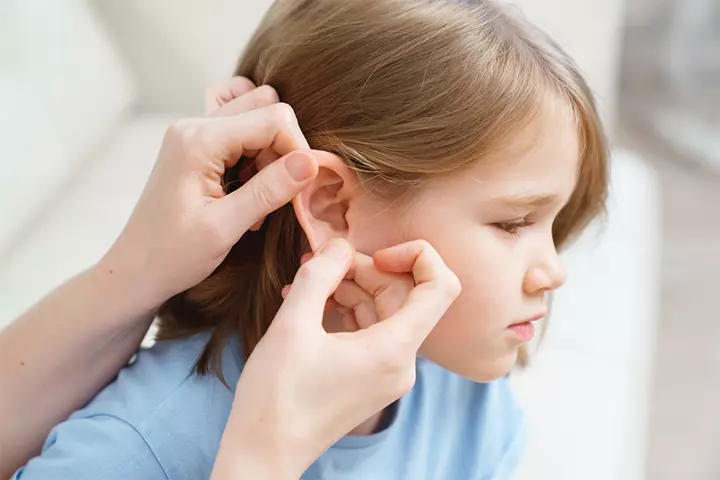
Image: Shutterstock
Roseola usually does not cause serious complications (5). However, high fever may result in febrile seizuresiSudden and abnormal surges of electrical activity in the brain characterized by jerking body movements and loss of consciousness. in some children. According to StatPearls Publishing by National Library of Medicine, febrile seizures are prevalent among 15% of children within the febrile phase of Roseola infantum. Children with high fever can also experience dehydration if they do not drink enough water during the illness. In a few cases, roseola can lead to ear infections in some children.
Can Children Get Roseola Twice?
The immune system develops antibodies against the roseola virus after the initial infection. Due to this, most children get roseola just once in their life (4). These antibodies can prevent viruses from causing diseases.
However, children with weakened immune systems may get roseola infection more than once since their immune system may not develop a proper defense against the disease.
Prevention Of Roseola In Children
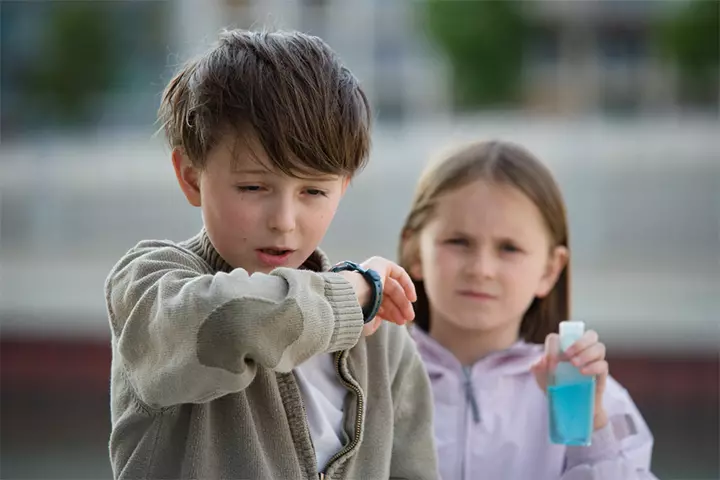
Image: Shutterstock
There is no vaccine or medications to prevent roseola (4). However, frequently washing the hands may help prevent roseola and many other common childhood illnesses, such as hand-foot-mouth disease (6). Practicing cough and sneeze etiquette may also prevent the spread of the disease.
Ensure you do not send your child to school if they have a fever or any other symptoms of roseola, and avoid exposing your child to another child with the infection.
When To Call A Doctor?
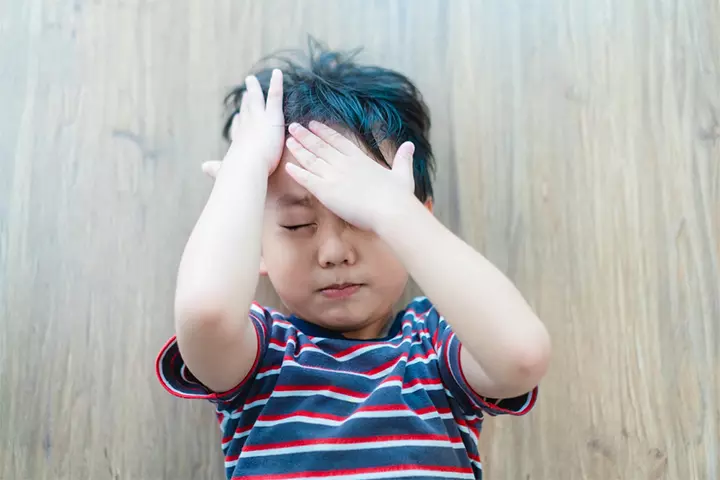
Image: Shutterstock
You may contact the pediatrician if your child develops severe breathing problems and signs of pneumonia. High degree fever may also require treatment to prevent seizures in children. Seizures, signs of dehydration, fatigue, or itchy or painful rashes are also indications you need to seek medical care.
Although roseola is not a severe disease, you may seek pediatrician help to prevent complications and exclude other conditions. Some studies show roseola can cause severe infections, such as meningitis and encephalitis, albeit in rare cases.
 Be watchful
Be watchfulDiagnosis Of Roseola In Children
A complete health history and the symptoms may help doctors in diagnosis. The onset and characteristics of skin rash and other symptoms may help the doctors confirm the diagnosis.
However, the diagnosis can often be confused with other conditions that appear with a viral rash in children, such as chickenpox rubellaiA viral infection (also called German measles) characterized by pink or red rashes, fever, and sore throat. or measlesiA highly contagious viral infection that can cause fever, rash, and other severe symptoms in children, often preventable by a vaccine. (5). In rare cases, a blood test is ordered to identify antibodies to roseola in a child’s body.
Treatment For Roseola
There is no specific vaccine or immunization for roseola. The treatment options may depend on the child’s age, health status, and severity of symptoms. Antiviral medications such as Cytovene (ganciclovir) are often prescribed for children with weakened immune systems (7).
Fever medications are prescribed for children with a high fever. Skin rash due to roseola does not require specific care since it does not cause any discomfort. In most cases, the infection in children can easily be managed by supportive care, which includes adequate rest and plenty of fluid intake, along with medications to reduce fever as a pediatrician recommends. Antibiotics are not used to treat roseola since it is a viral disease.
Children with roseola can return to school or childcare centers 24 hours after the fever subsides, even if they have skin rashes since they are no longer contagious.
 Point to consider
Point to considerHome Remedies For Roseola In Children
The following home remedies may help ease the symptoms of roseola in children (8).
- Give them plenty of water to prevent dehydration.
- Provide soft foods if your child has a sore throat.
- Give fever medications, such as acetaminophen (Tylenol), as per the doctor’s advice.
- Dress them in cotton or lightweight clothing to prevent excessive sweating during fever.
Do not give ibuprofen to children younger than six months and aspirin to children of all ages to treat fever.
Frequently Asked Questions
1. Can my child go to daycare with roseola?
Children with roseola must not go to daycare as long as they show symptoms of the condition since they may spread it to others (9).
2. Do I need to put any creams on my child’s rash?
Rashes from roseola do not usually cause irritation or discomfort and go away on their own. So applying creams or ointments is not required (9).
3. Is it possible to have roseola and not know it?
About two-thirds of the children with a roseola infection may not develop a rash. So their fever may be due to roseola, and their parents may not realize it as fever is a common symptom of several illnesses (4).
Roseola is a common viral infection. It is a highly contagious disease seen more commonly in children younger than two years old. Usually, roseola does not cause any side effects. Antibodies are created after contracting the infection for the first time; therefore, most children get infected only once. There are no medications or vaccines to prevent roseola. However, hand hygiene and cough and sneeze etiquette can help contain the spread of roseola in children. Prompt treatment should be provided to immunocompromisediA condition where a person’s immunity weakens significantly, making them more prone to infections and illnesses. children to contain the spread of infection.
Infographic: Differential Diagnosis Of Roseola In Children
Roseola is a common pediatric disease; however, given the number of conditions that can cause rashes in children, it can easily be misdiagnosed, causing a delay in the treatment. But awareness of the illnesses resembling roseola can help rule them out. Take a look at the infographic below to learn more about these conditions and their distinctive characteristics.
Some thing wrong with infographic shortcode. please verify shortcode syntax
This video shows the roseola rash and its symptoms in children. Watch to recognize and identify this common childhood illness.
Personal Experience: Source
MomJunction articles include first-hand experiences to provide you with better insights through real-life narratives. Here are the sources of personal accounts referenced in this article.
i. Roseola – running fever with no other symptoms.https://mybabysdish.wordpress.com/2015/03/09/roseola-running-fever-with-no-other-symptoms/
References
- Roseola.
https://www.cincinnatichildrens.org/health/r/roseola - Roseola in Children.
https://www.cedars-sinai.org/health-library/diseases-and-conditions—pediatrics/r/roseola-in-children.html - Roseola.
https://www.nhs.uk/conditions/roseola/ - Roseola.
https://my.clevelandclinic.org/health/diseases/15785-roseola-infantumsixth-disease - Roseola Infantum.
https://www.betterhealth.vic.gov.au/health/conditionsandtreatments/roseola-infantum - Roseola Infantum.
https://raisingchildren.net.au/guides/a-z-health-reference/roseola-infantum - Roseola Infantum.
https://www.msdmanuals.com/en-in/home/children-s-health-issues/common-viral-infections-in-infants-and-children/roseola-infantum/?autoredirectid=21732 - Roseola.
https://www.hopkinsmedicine.org/health/conditions-and-diseases/roseola - Roseola Infantum.
https://www.rch.org.au/kidsinfo/fact_sheets/Roseola_infantum/# - Roseola.
https://kidshealth.org/en/parents/roseola.html
Community Experiences
Join the conversation and become a part of our nurturing community! Share your stories, experiences, and insights to connect with fellow parents.
Read full bio of Dr. Dur Afshar Agha
Read full bio of Dr Bisny T. Joseph
Read full bio of Dr. Ritika Shah
Read full bio of Vidya Tadapatri






